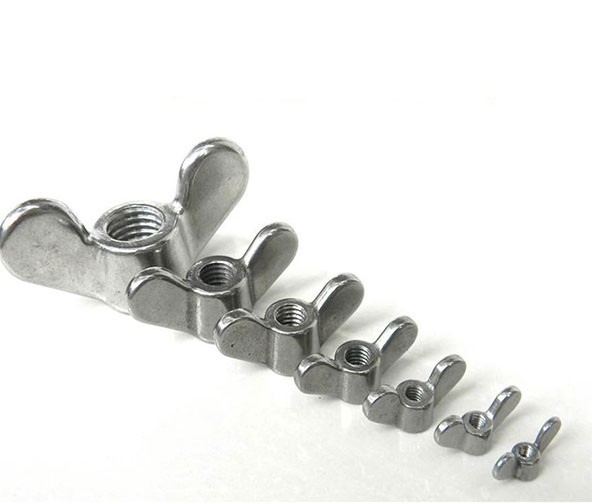What is a wing nut?
Wing nut (also known as butterfly nut), a small part that frequently appears in mechanical equipment and structures, actually contains rich process technology and precision design. Butterfly nut is a kind of nut with a unique shape. The protruding arc of the head looks like a beautiful butterfly. Butterfly nut is not only beautiful but also has many functions. Generally speaking, butterfly nuts can be divided into cold-headed butterfly nuts, cast butterfly nuts and stamped butterfly nuts according to their processing technology, and can be divided into two basic shapes according to their shape: square-wing butterfly nuts and round-wing nuts.
Its unique shape not only gives it a beautiful appearance but also brings great convenience in practical applications. From medical equipment to wind power, from aerospace to office equipment, butterfly wing nuts have won the favor of engineers and technicians with their excellent performance and wide application fields.
The manufacturing process behind wing nuts
The choice of raw materials
The material of the wing nut determines its performance and use. Common stainless steel, carbon steel and brass each have their own unique physical and chemical properties. When choosing, we need to determine the most suitable material according to the specific purpose and use environment of the product. At the same time, in order to ensure the quality and safety of the product, we also need to ensure that the selected material meets the relevant standards and specifications.
The processing technology

This is the most critical link in the manufacturing process of butterfly wing nuts. Cutting, thread processing, surface treatment, each step requires delicate operation and strict quality control. In the cutting stage, fastener manufacturers usually use cold heading, automatic lathe, thread rolling and other technologies to complete it. These technologies require not only high-precision equipment, but also experienced operators. In the cutting process, the selection and grinding of tools are crucial, and they directly affect the accuracy and efficiency of the product.
Then there is thread processing. This is a process that requires extremely high precision. We need to uniformly adjust the screw with threads to the corresponding length, and then use a thread rolling machine to roll up the threads on both sides to make screws. This process requires strict control of the size and accuracy of the threads to ensure the quality and performance of the nuts. Finally, it is surface treatment. The surface treatment of butterfly nuts can not only enhance the appearance of the product, but also increase its anti-oxidation and corrosion resistance. Common surface treatment methods include hot-dip galvanizing, electroplating, blackening, polishing, etc. These treatment methods require strict control of parameters such as processing time and temperature to ensure the stability and consistency of the treatment effect.
Throughout the manufacturing process, quality inspection is carried out throughout. We need to conduct comprehensive quality inspections on raw materials, cutting, thread processing, surface treatment, etc. This includes inspections of various aspects such as outer diameter, thread size, thread accuracy, surface treatment thickness, flatness, etc. Only after passing strict quality inspection can wing nut fasteners be recognized as qualified products and put into practical application.
In general, the manufacturing process of butterfly nuts is a complex and delicate process. It requires us to have advanced equipment and technology, and also requires us to have a strict quality control awareness. Only in this way can we manufacture high-quality, high-performance butterfly nuts to provide solid support for various mechanical equipment and structures.
 English
English



















